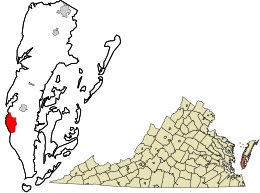Cape Charles, VA
| Cape Charles, Virginia | ||
|---|---|---|
| Town | ||

Bloxom Depot and the town water tower
|
||
|
||
 Location in Northampton County and the state of Virginia. |
||
| Coordinates: 37°16′3″N 76°0′51″W / 37.26750°N 76.01417°WCoordinates: 37°16′3″N 76°0′51″W / 37.26750°N 76.01417°W | ||
| Country | United States | |
| State | Virginia | |
| County | Northampton | |
| Government | ||
| • Mayor | George Proto | |
| • Vice-Mayor | Chris Bannon | |
| Area | ||
| • Total | 4.4 sq mi (11.3 km2) | |
| • Land | 3.7 sq mi (9.5 km2) | |
| • Water | 0.7 sq mi (1.8 km2) | |
| Elevation | 3 ft (1 m) | |
| Population (2010) | ||
| • Total | 1,009 | |
| • Density | 229.3/sq mi (89.3/km2) | |
| Time zone | Eastern (EST) (UTC−5) | |
| • Summer (DST) | EDT (UTC−4) | |
| ZIP code | 23310 | |
| Area code | 757 | |
| FIPS code | 51-12808 | |
| GNIS feature ID | 1492707 | |
| Website | Official website | |
Cape Charles is a town in Northampton County, Virginia, United States. The population was 1,009 at the 2010 census.
Cape Charles, located close to the mouth of the Chesapeake Bay, on Virginia's Eastern Shore, was founded in 1884 as a planned community by railroad and ferry interests. In 1883 Scott became president of the New York, Philadelphia and Norfolk Railroad Company (NYP&N), and purchased three plantations comprising approximately 2,509 acres from the heirs of former Virginia Governor Littleton Waller Tazewell. Of this land, 40 acres were ceded to the NYP&N, and 136 acres went to create the Town of Cape Charles. Some of this land, named Cape Charles for the cape found to the south, Scott sold to the Railroad Company to serve as the southern terminus. In that same year, construction of the railroad began. In Cape Charles, the Railroad Company built a harbor to handle steamships and freighters from Cape Charles to Norfolk. The original Town was approximately 136 acres divided into 644 equal lots. Seven avenues which run from east to west were named for Virginia statesmen; the streets which run north and south were named for fruits. The original layout of the Town is still very visible today.
Historian William G. Thomas writes, "At a cost of nearly $300,000, the N.Y., P. & N. was dredging a new harbor out of a large fresh-water lagoon between King's and Old Plantation creeks in lower Northampton County, and Scott planned to develop a new town around it called Cape Charles City. The appellation "City" for any place on the Eastern Shore was romantic, a vision of the future that the railroad might make possible....In 1890 the Corps of Engineers dredged the harbor basin, its entrance, and a channel through Cherrystone Inlet and built stone jetties protecting the harbor outlet. By 1912 the Corps estimated that Cape Charles harbor handled 2,500,000 tons of freight a year."
Cape Charles was, for many years, the terminal for the Little Creek-Cape Charles Ferry, providing passenger and car ferry service across the bay to Norfolk and Hampton. The last ferry left Cape Charles in 1963. Cape Charles still serves as a terminal for railway barges that carry rail cars from the former Eastern Shore Railroad which is now Bay Coast Railroad across the mouth of the bay to Norfolk. There is also a cement factory nearby.
...
Wikipedia

